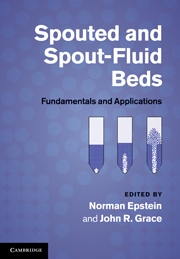Book contents
- Frontmatter
- Contents
- Contributors
- Preface
- Common nomenclature
- 1 Introduction
- 2 Initiation of spouting
- 3 Empirical and analytical hydrodynamics
- 4 Computational fluid dynamic modeling of spouted beds
- 5 Conical spouted beds
- 6 Hydrodynamics of spout-fluid beds
- 7 Spouted and spout-fluid beds with draft tubes
- 8 Particle mixing and segregation
- 9 Heat and mass transfer
- 10 Powder–particle spouted beds
- 11 Drying of particulate solids
- 12 Drying of solutions, slurries, and pastes
- 13 Granulation and particle coating
- 14 The Wurster coater
- 15 Gasification, pyrolysis, and combustion
- 16 Spouted bed electrochemical reactors
- 17 Scaleup, slot-rectangular, and multiple spouting
- 18 Mechanical spouting
- 19 Catalytic reactors and their modeling
- 20 Liquid and liquid–gas spouting of solids
- Index
- References
8 - Particle mixing and segregation
Published online by Cambridge University Press: 04 February 2011
- Frontmatter
- Contents
- Contributors
- Preface
- Common nomenclature
- 1 Introduction
- 2 Initiation of spouting
- 3 Empirical and analytical hydrodynamics
- 4 Computational fluid dynamic modeling of spouted beds
- 5 Conical spouted beds
- 6 Hydrodynamics of spout-fluid beds
- 7 Spouted and spout-fluid beds with draft tubes
- 8 Particle mixing and segregation
- 9 Heat and mass transfer
- 10 Powder–particle spouted beds
- 11 Drying of particulate solids
- 12 Drying of solutions, slurries, and pastes
- 13 Granulation and particle coating
- 14 The Wurster coater
- 15 Gasification, pyrolysis, and combustion
- 16 Spouted bed electrochemical reactors
- 17 Scaleup, slot-rectangular, and multiple spouting
- 18 Mechanical spouting
- 19 Catalytic reactors and their modeling
- 20 Liquid and liquid–gas spouting of solids
- Index
- References
Summary
This chapter starts from the state of the art on particle mixing in spouted beds, as presented in the classical book by Mathur and Epstein. In subsequent years, segregation has been considered in fundamental studies aimed at describing real systems of various bed compositions.
Gross solids mixing behavior
The mixing properties of spouted beds result from interaction among the spout, fountain, and annulus. In a continuously operated unit, the positioning of the solids inlet port with respect to the discharge opening is of fundamental importance to prevent bypassing. Dead zones could arise from problematic solids circulation – for example, because of an incorrect base design. To prevent segregation, the simplest conceivable operating condition corresponds to a mono-sized particulate material and a single unit in which each particle undergoes many cycles before being discharged. In such cases and for continuous operation, the internal circulation far exceeds the net in-and-out flow of solids in all cases studied. The very different particle residence times in the spout (progressively loaded with solids along its height), in the fountain (where the particles have both axial and radial velocity components), and in the annulus (where particles travel downward in nearly plug flow) generate nearly well-mixed overall solids residence time distributions (RTDs).
Stimulus-response techniques have been applied to determine the RTD of particles. A typical downstream normalized tracer concentration at the discharge, called the F curve, generated in response to an upstream step input of colored particles, is given in Figure 8.1.
- Type
- Chapter
- Information
- Spouted and Spout-Fluid BedsFundamentals and Applications, pp. 141 - 160Publisher: Cambridge University PressPrint publication year: 2010
References
- 4
- Cited by



